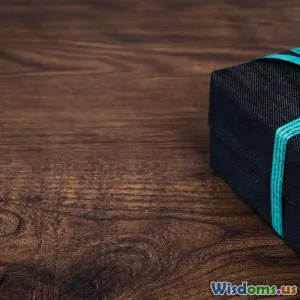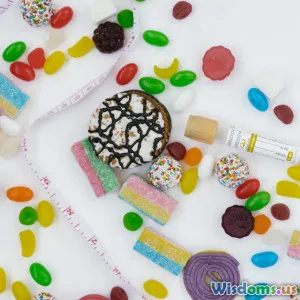
Comparing Food Packaging Choices Compostable vs Recyclable
17 min read A comprehensive comparison of compostable and recyclable food packaging, exploring their benefits, challenges, and real-world impact on the environment and economy. (0 Reviews)
Compostable vs Recyclable: The Food Packaging Showdown
It’s lunchtime, and you’re grabbing a salad-to-go from your favorite café. The packaging looks eco-friendly—sporting green hues and words like “compostable” or “100% recyclable.” But which truly makes the difference for our planet: compostable or recyclable food packaging? The answer is nuanced, and understanding it can empower us as consumers and business owners to make choices that actually benefit the environment, and not just appease our conscience.
Table of Contents
- Introduction
- What defines Compostable and Recyclable Packaging?
- Materials & Manufacturing: What Goes In Matters
- Processing Infrastructure: Can Our Cities Handle It?
- Environmental Impact: Landfill or Lifeline?
- Consumer Behavior and Contamination
- Cost, Scalability, and Business Considerations
- Real-World Insights: Cities, Brands, and Case Studies
- Choosing Wisely: Guidance for Better Decisions
- Conclusion
Introduction
Picture this: The world produces over 300 million tons of plastic every year, half intended for single-use purposes such as food packaging. According to the United Nations Environment Programme (UNEP), less than 10% of all the plastic ever produced has been recycled. Meanwhile, cities globally are racing to introduce composting systems, with “compostable” packaging often heralded as an environmental panacea. But as we line up to purchase sandwiches in that eco-labeled packaging, are these materials living up to their promise, or are we inadvertently contributing to the waste problem in new ways?
Let’s peel back the layers and decode the reality behind “compostable” and “recyclable” food packaging. The stakes are high: Our choices shape not only our local environments but the global landscape. Which is better for your sandwich—and the planet?
What Defines Compostable and Recyclable Packaging?
Compostable Packaging: From Soil to Soil
Compostable packaging is designed to break down into nutrient-rich compost with the help of microorganisms, heat, and moisture. According to industry standards like ASTM D6400 (US) and EN 13432 (EU), compostable products should disintegrate within 90-180 days under industrial conditions, leaving behind no toxic residue.
- Examples: PLA (polylactic acid) takeout clamshells, bagasse fiber trays, and even compostable cutlery made from maize starch.
“Compostable doesn’t just mean ‘breaks down’—it must do so without harming the soil and in a reasonable time,” remarks Dr. Linda Godfrey, waste policy expert.
Recyclable Packaging: Closed-Loop Potential—but with Caveats
Recyclable packaging is designed to be collected, cleaned, processed, and turned back into new products. Materials must be separated by type (PET (#1), HDPE (#2), glass, metal), and free from contaminants.
- Examples: PET plastic salad boxes, aluminum soda cans, cardboard pizza boxes (unsoiled), and glass jars.
“Recycling, when executed properly, can keep materials alive in the economy for generations. But contamination and lack of demand can undermine the whole process,” says Nancy Parker, director at RecycleWorks.
Materials & Manufacturing: What Goes In Matters
Compostable Materials: Renewable but Sometimes Complicated
Many compostable products are plant-based. PLA is derived from fermented plant starch (usually corn or sugarcane). Bagasse comes from sugarcane fibers left after juice extraction. These materials often require less fossil fuel in their creation compared to traditional plastics.
- Energy usage: Studies indicate production of PLA uses about 65% less energy compared to PET plastics.
- GHG emissions: Compostable plastics can produce 25-50% fewer greenhouse gases during manufacturing, depending on the source material and processes used.
Caveat: Growing crops for bioplastic can stress water resources and compete with food production—especially when sourced from industrial farms.
Recyclable Materials: Tried and Tested
PET, HDPE, and aluminum are industry standards. For instance, creating an aluminum can from recycled material uses 95% less energy than producing it from raw bauxite.
Paper and cardboard are also recyclable but must be kept clean. Food-soiled boxes, for example, often end up as trash.
Concerns: Extraction of raw materials—such as oil for plastics or bauxite for aluminum—remains highly resource-intensive unless recycling rates are high.
Processing Infrastructure: Can Our Cities Handle It?
Composting Capabilities: Still Developing
The success of compostable packaging is mostly dependent on appropriate waste collection and processing infrastructure. Most city composting facilities are industrial rather than home-based, operating at temperatures above 55°C (131°F) and controlled aeration.
- As of 2023, only about 10% of U.S. residents have access to industrial composting facilities that accept compostable plastics. (Source: Sustainable Packaging Coalition)
- Lightweight home compostable packages often break down only partially on home compost heaps, particularly those made with bioplastics.
“Most consumers are unaware that throwing a PLA cup into backyard compost won’t work. A city composter is needed—but those are scarce,” notes Adam Rossi, urban waste manager.
Recycling Realities: A Spread but Strained System
Curbside recycling programs are common—but not all plastics are actually recycled. Only PET and HDPE bottles/jugs generally get processed. Black plastics, films, and multi-layered paper/plastic packages often go to landfill or incineration.
- Globally, only 9% of plastic is recycled, 12% incinerated, and 79% ends up in landfill or the environment. (UNEP)
- Local rules vary sharply: Some cities recycle almost everything, while others only process bottles and cans.
Dirty packaging (think greasy pizza boxes) is another dilemma; they can contaminate whole recycling batches, resulting in disposal.
Environmental Impact: Landfill or Lifeline?
Compostables: Only as Good as The System
Compostable packaging can bring value—when properly processed. Turned into rich soil, it displaces synthetic fertilizers and helps retain carbon in the earth. But what happens if it ends up in a landfill?
-
If compostables are sent to landfill (as happens in most municipalities), their breakdown is delayed due to lack of oxygen and may even release methane, a potent greenhouse gas (over 25x more impactful than CO₂ over 100 years).
-
Home and community composters rarely reach the high temperatures necessary; tough bioplastics might persist for years.
Recyclables: Circular—In Theory
Recycling, in principle, reduces the need for virgin materials, slashing energy use and pollution.
- Aluminum, when recycled, saves significant energy and decreases mining.
- PET bottles, if clean and sorted, often become new containers, fibers for clothing, or carpets.
Yet, recycling faces “downcycling”—where plastics lose strength or quality, eventually becoming non-recyclable trash. Even with well-equipped pull systems, not everything makes it back into the loop.
- Data Point: A 2022 Greenpeace report found only 5% of plastics collected in the U.S. were reprocessed into new products successfully.
Side-by-Side Impact Table
| Criteria | Compostable Packaging | Recyclable Packaging |
|---|---|---|
| Resource base | Renewable (plants) | Mix (fossil, minerals, paper) |
| Production energy | Lower (for PLA, bagasse) | Lower if recycled content |
| Recycling/Composting | Needs special facilities | Widespread, but imperfect |
| Landfill impact | Can release methane | Fills landfill (plastics never biodegrade) |
| Soil/fertilizer offset | Positive if composted | N/A |
| Lifetime reuse | Typically single-use | Multiple cycles |
Consumer Behavior and Contamination
Compostables and recyclables are both susceptible to consumer confusion. A misstep in sorting can send an otherwise “green” product to the wrong place, negating intended benefits.
- Wishcycling: Tossing what feels recyclable/compostable into blue bins, hoping it gets managed properly—often it doesn’t.
- Labels: Vague or misleading labels (like “biodegradable” vs. “compostable”) confuse consumers. Only true compostable goods, certified by the BPI (Biodegradable Products Institute) or similar groups, guarantee breakdown in municipal composting environments.
A 2021 EcoFocus Worldwide Survey found that 68% of consumers could not distinguish between “compostable,” “biodegradable,” and “recyclable”—leading to ongoing contamination issues in waste streams. For example:
- Compostable PLA cups in plastics recycling contaminate the batch (can’t be processed together).
- Greasy pizza boxes in recycling bins render a load of otherwise recyclable paper unrecyclable.
“The greatest challenge is consumer education and clear labeling,” says Allison Bryant of WasteWatch. “Even the perfect packaging fails its environmental promise if mismanaged.”
Cost, Scalability, and Business Considerations
Cost Comparison
Compostable packaging generally costs more to produce than conventional plastics or some recycled alternatives—sometimes 2-3x more, according to a 2023 Sheffield University study. However, prices have begun to fall as demand and supply increase.
Recyclable containers, especially those made from recycled PET or paper, tend to be cheaper and more widely available at commercial scale.
Scalability and Policy
Government incentives can shift the economics. For example, the European Union’s Single Use Plastics Directive (2021) limits certain plastic items, encouraging the rise of compostable and recyclable innovations. Some U.S. cities, like San Francisco, have implemented plastic straw bans, leading chains like Starbucks and McDonald’s to pilot compostable/biodegradable alternatives.
Yet, without collection and processing infrastructure—or clear mandates on labeling and design for recycling—progress can stall.
Real-World Insights: Cities, Brands, and Case Studies
Cities Leading the Way
- San Francisco: Requires compostable foodware at restaurants and has invested heavily in organic waste collection. This resulted in a successful diversion rate—composting 750 tons of organic material daily.
- Toronto: While excellent at paper and plastic recycling, compostable packaging lags; most still ends up in trash due to processing limitations.
- London (UK): “Vegware” compostable packaging has grown in popularity, yet recent reports indicate much is incinerated or landfilled—not composted—because of confused waste streams.
Brand Initiatives
- Nestlé: Piloted paper and compostable flexible pouches but highlighted challenges with consumer disposal accuracy and supply chain adaptations.
- Sweetgreen: Uses compostable bowls, but can only deliver on their sustainability promise in cities where industrial composting works. In others, the bowls end in landfill.
- Loop: This startup offers reusable/refillable food packaging—showing a “third way” for ambitious sustainability programs, but logistics and customer participation remain hurdles.
Choosing Wisely: Guidance for Better Decisions
With so many variables, how can businesses and consumers make the best call?
1. Know the Infrastructure
- Check if your locality collects and processes industrial compostables before purchasing compostable containers in bulk.
- Confirm which plastics are accepted by your recycler before ordering “recyclable” packaging.
2. Design for Minimalism
- Excessive or multi-material packages (plastic/foil hybrids) often doom recycling or composting efforts. Simpler designs succeed.
3. Push for Clearer Labeling
- Support efforts like “How2Recycle” or “Compostable Certification” labels that clarify disposal, and encourage brands to use standardized logos.
4. Prioritize Local Solutions
- Compostable packaging shines where composting systems are robust—restaurants, campuses, event venues with dedicated compost bins manage this best.
- Recycling is proven in places with clean, separated streams and high public awareness.
5. Educate and Engage
- Empower staff and customers with clear signage, demo events, or digital guides on sorting. Misinformation and apathy are fatal to sustainability efforts.
Pro Tip: Sometimes, the Most Sustainable Choice Is No Packaging!
Bulk-buying, bringing your own reusable containers, and favoring dine-in can outweigh any single-use option—regardless of its eco-labels.
Conclusion
When comparing compostable vs recyclable food packaging, the winner truly depends on context. Compostable packaging’s success is rooted in powerful local composting systems and educated consumers. Recyclable packaging relies on clean input streams and genuine demand for recycled materials. The biggest takeaway: “Eco-friendly” branding alone is not a silver bullet. Lasting impact results from systemic thinking—a union of smart material use, infrastructure investment, honest labeling, and active participation at every stage of the food chain.
For planet-forward change, step one isn’t merely choosing compostable over recyclable (or vice versa) at the checkout—it’s understanding your local context and pushing for systems that will bring out the best in whatever you choose. The responsibility does not lie with packaging alone, but with all of us: brands, consumers, and our cities. Next time you grab lunch on-the-go, look deeper. Your seemingly small packaging choice just might tip the scales for the environment.
Rate the Post
User Reviews
Other posts in Food & Sustainability
Popular Posts














